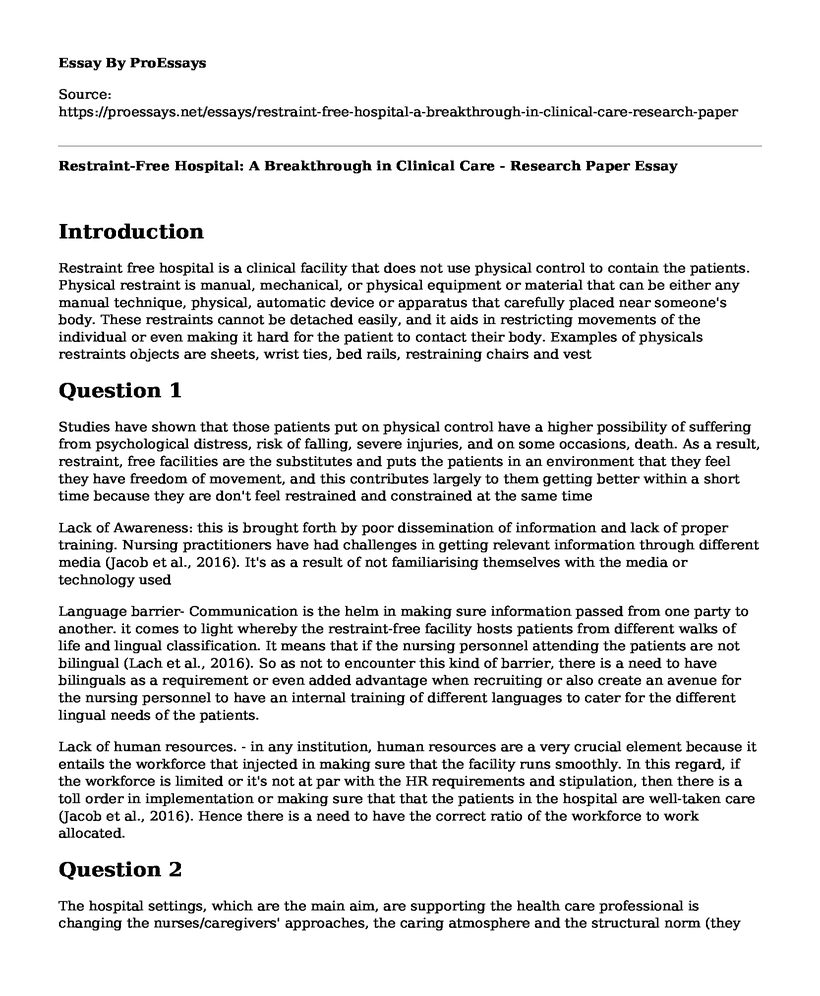Introduction
Restraint free hospital is a clinical facility that does not use physical control to contain the patients. Physical restraint is manual, mechanical, or physical equipment or material that can be either any manual technique, physical, automatic device or apparatus that carefully placed near someone's body. These restraints cannot be detached easily, and it aids in restricting movements of the individual or even making it hard for the patient to contact their body. Examples of physicals restraints objects are sheets, wrist ties, bed rails, restraining chairs and vest
Question 1
Studies have shown that those patients put on physical control have a higher possibility of suffering from psychological distress, risk of falling, severe injuries, and on some occasions, death. As a result, restraint, free facilities are the substitutes and puts the patients in an environment that they feel they have freedom of movement, and this contributes largely to them getting better within a short time because they are don't feel restrained and constrained at the same time
Lack of Awareness: this is brought forth by poor dissemination of information and lack of proper training. Nursing practitioners have had challenges in getting relevant information through different media (Jacob et al., 2016). It's as a result of not familiarising themselves with the media or technology used
Language barrier- Communication is the helm in making sure information passed from one party to another. it comes to light whereby the restraint-free facility hosts patients from different walks of life and lingual classification. It means that if the nursing personnel attending the patients are not bilingual (Lach et al., 2016). So as not to encounter this kind of barrier, there is a need to have bilinguals as a requirement or even added advantage when recruiting or also create an avenue for the nursing personnel to have an internal training of different languages to cater for the different lingual needs of the patients.
Lack of human resources. - in any institution, human resources are a very crucial element because it entails the workforce that injected in making sure that the facility runs smoothly. In this regard, if the workforce is limited or it's not at par with the HR requirements and stipulation, then there is a toll order in implementation or making sure that that the patients in the hospital are well-taken care (Jacob et al., 2016). Hence there is a need to have the correct ratio of the workforce to work allocated.
Question 2
The hospital settings, which are the main aim, are supporting the health care professional is changing the nurses/caregivers' approaches, the caring atmosphere and the structural norm (they include the leadership, the interpersonal relations between nurses). When focusing solely on the deterrence of possibly risky events and the belief that physically restrain use will be useful in reducing falls-related injuries in the hospital (Lach et al., 2016). These beliefs and culture may lead to one considering the use of physical restraints as being the perfect tools to use, to the alternative strategies. The implementation of a less restraining policy in clinical practice may not be useful in the hospital because of a lack of know-how by the staff to such systems; hence training is required for the medical staff. Also, in the introduction of other equipment that is safe like sensor mats that offer other alternatives to the physical restraints, which in turn reduce the risk of falling and also low beds that help patients and reduce the rate of accidents related to falls from the bed. The hiring of well-trained clinical staff is another factor that helps in the addressing of the anticipated barriers, and hence the less use of the physical restrains to the patients.
Question 3
Changing health care systems and the changing profile of the patients entail that the system undergoes a vital shift to deliver patient-centered care, as opposed to specialty care. Nursing is another significant occupation in healthcare (Lach et al., 2016). The modern nursing has reinvented itself to become a caregiver that has changed and advanced. With this in mind, the nursing profession's resourcefulness and adaptive ability are essential, which has attracted several nurses who are more broadly and talented leading to expanded scopes of practice and responsibilities. Nursing has become one of the most distinguished careers in the health sector and an enabling force with many dimensions.
Conclusion
The new concept of management of patient behaviors in a restraint-free hospital has seen much advancement in the studies, in regards to management and technology of handling the patients. The introduction of technology that can enable a patient to be free and move around the hospital facility without any restrain is advancement in the medical profession.
Reference
Jacob, T., Sahu, G., Frankel, V., Homel, P., Berman, B., & McAfee, S. (2016). Patterns of restraint utilization in a community hospital's psychiatric inpatient units. Psychiatric Quarterly, 87(1), 31-48. doi: 10.1007/s11126-015-9353-7
Lach, H. W., Leach, K. M., & Butcher, H. K. (2016). Changing the practice of physical restraint use in acute care. Journal of gerontological nursing, 42(2), 17-26. Retrieved from 5 April 2020, https://www.researchgate.net/publication/6494382_Evidence-based_guideline_Changing_the_practice_of_physical_restraint_use_in_acute_care
Cite this page
Restraint-Free Hospital: A Breakthrough in Clinical Care - Research Paper. (2023, May 08). Retrieved from https://proessays.net/essays/restraint-free-hospital-a-breakthrough-in-clinical-care-research-paper
If you are the original author of this essay and no longer wish to have it published on the ProEssays website, please click below to request its removal:
- Deceptive Social Media Advertising of Pharmaceutical Products - Coursework Example
- Implications of the ANA's Position on Ethics - Essay Sample
- Regulation for Nursing Practice Staff Development Meeting - Essay Sample
- Emergency Management Article Review
- Paper Sample on Human Body: Hormones Essential for Reproduction & Functioning
- Essay Sample on Obesity: Investigated Disease Process
- Research Paper on Equality in Education: An Inclusive Right for All







